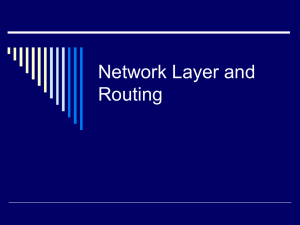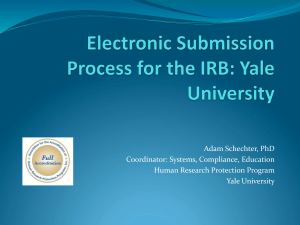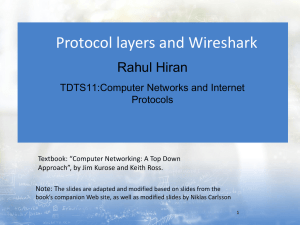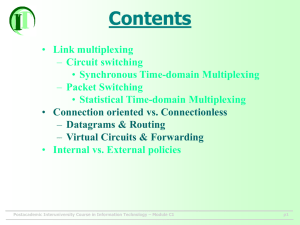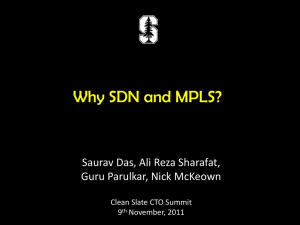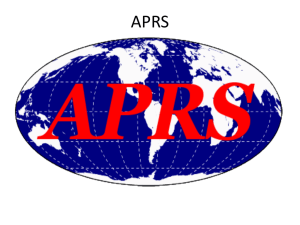1 - Routing Basics
advertisement
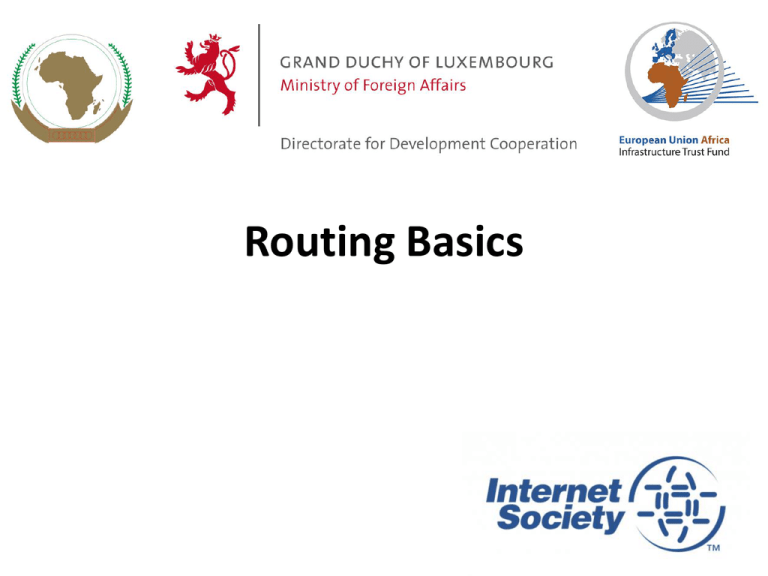
Routing Basics 1 Routing Concepts • • • • • • IPv4 Routing Forwarding Some definitions Policy options Routing Protocols 2 IPv4 • Internet uses IPv4 – Addresses are 32 bits long – Range from 1.0.0.0 to 223.255.255.255 – 0.0.0.0 to 0.255.255.255 and 224.0.0.0 to 255.255.255.255 have “special” uses • IPv4 address has a network portion and a host portion 3 IPv4 address format • Address and subnet mask – written as – 12.34.56.78 255.255.255.0 or – 12.34.56.78/24 – mask represents the number of network bits in the 32 bit address – the remaining bits are the host bits 4 What does a router do? 5 A day in a life of a router find path forward packet, forward packet, forward packet, forward packet... find alternate path forward packet, forward packet, forward packet, forward packet… repeat until powered off 6 Routing versus Forwarding • Routing = building maps and giving directions • Forwarding = moving packets between interfaces according to the “directions” 7 IP Routing – finding the path • Path derived from information received from a routing protocol • Several alternative paths may exist – best path stored in forwarding table • Decisions are updated periodically or as topology changes (event driven) • Decisions are based on: – topology, policies and metrics (hop count, filtering, delay, bandwidth, etc.) 8 IP route lookup • Based on destination IP address • “longest match” routing – More specific prefix preferred over less specific prefix – Example: packet with destination of 10.1.1.1/32 is sent to the router announcing 10.1/16 rather than the router announcing 10/8. 9 IP route lookup • Based on destination IP address Packet: Destination IP address: 10.1.1.1 R1 10/8 announced from here R3 R2 10/8 R3 10.1/16 R4 20/8 R5 30/8 R6 ….. R4 10.1/16 announced from here R2’s IP routing table 10 IP route lookup: Longest match routing • Based on destination IP address Packet: Destination IP address: 10.1.1.1 R1 10/8 announced from here R3 R2 R4 10.1.1.1 && FF.0.0.0 10/8 R3 vs. Match! 10.1/16 10.0.0.0 && FF.0.0.0 R4 20/8 R5 30/8 R6 ….. IP routing table R2’s 10.1/16 announced from here 11 IP route lookup: Longest match routing • Based on destination IP address Packet: Destination IP address: 10.1.1.1 R1 10/8 announced from here R3 R2 R4 10/8 R3 10.1/16 R4 20/8 R5 30/8 R6 ….. 10.1/16 announced 10.1.1.1 && FF.FF.0.0 Match as well! from here vs. 10.1.0.0 && FF.FF.0.0 R2’s IP routing table 12 IP route lookup: Longest match routing • Based on destination IP address Packet: Destination IP address: 10.1.1.1 R1 10/8 announced from here R3 R2 R4 10/8 R3 10.1/16 R4 20/8 R5 30/8 R6 ….. 10.1/16 announced from here 10.1.1.1 && FF.0.0.0 Does not match! vs. 20.0.0.0 && FF.0.0.0 R2’s IP routing table 13 IP route lookup: Longest match routing • Based on destination IP address Packet: Destination IP address: 10.1.1.1 R1 10/8 announced from here R3 R2 R4 10/8 R3 10.1/16 announced 10.1/16 R4 from here 10.1.1.1 && FF.0.0.0 20/8 R5 vs. Does not match! 30/8 R6 30.0.0.0 && FF.0.0.0 ….. R2’s IP routing table 14 IP route lookup: Longest match routing • Based on destination IP address Packet: Destination IP address: 10.1.1.1 R1 10/8 announced from here R3 R2 R4 10/8 R3 10.1/16 R4 20/8 R5 30/8 R6 ….. 10.1/16 announced Longest match, 16 bit netmask from here R2’s IP routing table 15 IP Forwarding • Router decides which interface a packet is sent to • Forwarding table populated by routing process • Forwarding decisions: – destination address – class of service (fair queuing, precedence, others) – local requirements (packet filtering) • Forwarding is usually aided by special hardware 16 Routing Information Base (RIB) Forwarding Information Base (FIB) Routing Tables Feed the Forwarding Table BGP 4 Routing Table OSPF – Link State Database Connected Routes Static Routes 17 RIBs and FIBs • FIB is the Forwarding Table – It contains destinations and the interfaces to get to those destinations – Used by the router to figure out where to send the packet – Careful! Some people still call this a route! • RIB is the Routing Table – It contains a list of all the destinations and the various next hops used to get to those destinations – and lots of other information too! – One destination can have lots of possible next-hops – only the best next-hop goes into the FIB 18 Explicit versus Default Routing • Default: – simple, cheap (cycles, memory, bandwidth) – low granularity (metric games) • Explicit (default free zone) – high overhead, complex, high cost, high granularity • Hybrid – minimise overhead – provide useful granularity – requires some filtering knowledge 19 Egress Traffic • How packets leave your network • Egress traffic depends on: – route availability (what others send you) – route acceptance (what you accept from others) – policy and tuning (what you do with routes from others) – Peering and transit agreements 20 Ingress Traffic • How packets get to your network and your customers’ networks • Ingress traffic depends on: – what information you send and to whom – based on your addressing and AS’s – based on others’ policy (what they accept from you and what they do with it) 21 Autonomous System (AS) AS 100 • Collection of networks with same routing policy • Single routing protocol • Usually under single ownership, trust and administrative control 22 Definition of terms • Neighbours – AS’s which directly exchange routing information – Routers which exchange routing information • Announce – send routing information to a neighbour • Accept – receive and use routing information sent by a neighbour • Originate – insert routing information into external announcements (usually as a result of the IGP) • Peers – routers in neighbouring AS’s or within one AS which exchange routing and policy information 23 Routing flow and packet flow packet flow AS 1 accept announce routing flow announce accept AS 2 packet flow For networks in AS1 and AS2 to communicate: AS1 must announce to AS2 AS2 must accept from AS1 AS2 must announce to AS1 AS1 must accept from AS2 24 Routing flow and Traffic flow • Traffic flow is always in the opposite direction of the flow of Routing information – Filtering outgoing routing information inhibits traffic flow inbound – Filtering inbound routing information inhibits traffic flow outbound 25 Routing Flow/Packet Flow: With multiple ASes AS 1 AS 34 N1 AS16 AS 8 N16 • For net N1 in AS1 to send traffic to net N16 in AS16: – – – – AS16 must originate and announce N16 to AS8. AS8 must accept N16 from AS16. AS8 must announce N16 to AS1 or AS34. AS1 must accept N16 from AS8 or AS34. • For two-way packet flow, similar policies must exist for N1 26 Routing Flow/Packet Flow: With multiple ASes AS 1 AS 34 N1 AS16 AS 8 N16 • As multiple paths between sites are implemented it is easy to see how policies can become quite complex. 27 Routing Policy • Used to control traffic flow in and out of an ISP network • ISP makes decisions on what routing information to accept and discard from its neighbours – – – – Individual routes Routes originated by specific ASes Routes traversing specific ASes Routes belonging to other groupings • Groupings which you define as you see fit 28 Routing Policy Limitations red red Internet green AS99 green packet flow • AS99 uses red link for traffic to the red AS and the green link for remaining traffic • To implement this policy, AS99 has to: – Accept routes originating from the red AS on the red link – Accept all other routes on the green link 29 Routing Policy Limitations red red Internet AS99 AS22 green green packet flow • AS99 would like packets coming from the green AS to use the green link. • But unless AS22 cooperates in pushing traffic from the green AS down the green link, there is very little that AS99 can do to achieve this aim 30 Routing Policy Issues • Late May 2012: – 410000 prefixes • Not realistic to set policy on all of them individually – 42000 origin AS’s • Too many to try and create individual policies for • Routes tied to a specific AS or path may be unstable regardless of connectivity • Solution: Groups of AS’s are a natural abstraction for filtering purposes 31 Routing Protocols We now know what routing means… …but what do the routers get up to? And why are we doing this anyway? 32 1: How Does Routing Work? • Internet is made up of the ISPs who connect to each other’s networks • How does an ISP in Kenya tell an ISP in Japan what customers they have? • And how does that ISP send data packets to the customers of the ISP in Japan, and get responses back – After all, as on a local ethernet, two way packet flow is needed for communication between two devices 33 2: How Does Routing Work? • ISP in Kenya could buy a direct connection to the ISP in Japan – But this doesn’t scale – thousands of ISPs, would need thousands of connections, and cost would be astronomical • Instead, ISP in Kenya tells his neighbouring ISPs what customers he has – And the neighbouring ISPs pass this information on to their neighbours, and so on – This process repeats until the information reaches the ISP in Japan 34 3: How Does Routing Work? • This process is called “Routing” • The mechanisms used are called “Routing Protocols” • Routing and Routing Protocols ensures that the Internet can scale, that thousands of ISPs can provide connectivity to each other, giving us the Internet we see today 35 4: How Does Routing Work? • ISP in Kenya doesn’t actually tell his neighbouring ISPs the names of the customers – (network equipment does not understand names) • Instead, he has received an IP address block as a member of the Regional Internet Registry serving Kenya – His customers have received address space from this address block as part of their “Internet service” – And he announces this address block to his neighbouring ISPs – this is called announcing a “route” 36 Routing Protocols • Routers use “routing protocols” to exchange routing information with each other – IGP is used to refer to the process running on routers inside an ISP’s network – EGP is used to refer to the process running between routers bordering directly connected ISP networks 37 What Is an IGP? • Interior Gateway Protocol • Within an Autonomous System • Carries information about internal infrastructure prefixes • Two widely used IGPs: – OSPF – ISIS 38 Why Do We Need an IGP? • ISP backbone scaling – Hierarchy – Limiting scope of failure – Only used for ISP’s infrastructure addresses, not customers or anything else – Design goal is to minimise number of prefixes in IGP to aid scalability and rapid convergence 39 What Is an EGP? • Exterior Gateway Protocol • Used to convey routing information between Autonomous Systems • De-coupled from the IGP • Current EGP is BGP 40 Why Do We Need an EGP? • Scaling to large network – Hierarchy – Limit scope of failure • Define Administrative Boundary • Policy – Control reachability of prefixes – Merge separate organisations – Connect multiple IGPs 41 Interior versus Exterior Routing Protocols • Interior – automatic neighbour discovery – generally trust your IGP routers – prefixes go to all IGP routers – binds routers in one AS together • Exterior – specifically configured peers – connecting with outside networks – set administrative boundaries – binds AS’s together 42 Interior versus Exterior Routing Protocols • Interior – Carries ISP infrastructure addresses only – ISPs aim to keep the IGP small for efficiency and scalability • Exterior – Carries customer prefixes – Carries Internet prefixes – EGPs are independent of ISP network topology 43 Hierarchy of Routing Protocols Other ISPs BGP4 BGP4 and OSPF/ISIS BGP4 IXP Static/BGP4 Customers 44 FYI: Cisco IOS Default Administrative Distances Route Source Default Distance Connected Interface Static Route Enhanced IGRP Summary Route External BGP Internal Enhanced IGRP IGRP OSPF IS-IS RIP EGP External Enhanced IGRP Internal BGP Unknown 0 1 5 20 90 100 110 115 120 140 170 200 255 45 Routing Basics End 46


